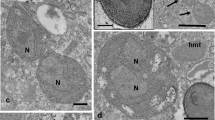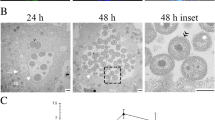Abstract
Free-living amoebae (FLA) occur ubiquitously in many aquatic habitats and humid soils as well as in “artificial” water samples. In addition to their role as pathogens, FLA are known to serve as natural hosts and vehicles of transmission for various intracellular organisms. An otherwise healthy 24-year-old female patient presented with keratitis in her inflamed left eye. She was a contact lens wearer and had no history of corneal trauma. No acanthamoebae could be determined by culture methods. A Vannella strain (called VanAun0) isolated from corneal scra**s showed intracellular aggregating organisms. Within 1–2 days, the host amoebae ruptured, and numerous coccoid organisms (called Kaun1) were released. We succeeded in detecting the mechanisms of infection and intrusion of this eukaryotic organism, growing within the nucleus of the FLA, by light and electron microscopy. It could be shown that the spores at the cell membrane of strain KAun1 resemble Microsporidia and were taken up into the Amoeba by phagocytosis after adhesion of the spores and food cup formation (infective phase). The spores were transported into the cytoplasm of the vannellae in food vacuoles. Phase contrast microscopy revealed early stages of the parasites moving through the cytoplasm into the nucleus of the host amoeba. Electron microscopy showed the proliferation of polymorphic stages within the karyoplasm. The life cycle of these microsporidian-like organisms ended up with a sporogenic phase in which a terminal differentiation took place and numerous spores were released by rupture of the host cell wall. With the rupture of the host amoeba’s cell membrane, the cycle started again from the beginning, the released infectious spores being ingested by other host amoebae. In particular, the morphology of the organelles made visible by electron microscopy finally allowed us to classify the endocytobionts as a microsporidan-like organism. Infection of Vannella sp. with the microsporidia-like organism strain KAun1 is a suitable model for studying the host–parasite relations of organisms using their hosts as so-called Trojan horses.








Similar content being viewed by others
References
Dunn AM, Terry RS, Smith JE (2001) Transovarial transmission in the microsporidia. Adv Parasitol 48:57–92
Greub G, Raoult D (2004) Microorganisms resistant to free-living amoebae. Clin Microbiol Rev 17(2):413–433
Groß U (2003) Treatment of microsporidiosis including albendazole. Parasitol Res 90:14–18
Jadin JB, Francois J, Bisoux M, Languillon J, Moris R (1968) Development intranucleaire de Mycobacterium leprae dans les cellules histiocytaires chez l’animal. Bull Acad Natl Méd 152:S7–S8
Karnovsky MJ (1965) A formaldehyde–glutaraldehyde fixative of high osmolality in electron microscopy. J Cell Biol 27:137A
Lom J, Dykova I (2002) Ultrastructure of Nucleospora secunda n.sp. (Microsporidia), parasite of enterocytes of Nothobranchius rubripinnis. Eur J Protistol 38:19–27
Michel R, Hauröder-Philippczyk B, Müller K-D, Weishaar I (1994) Acanthamoeba from human nasal mucosa infected with an obligate intracellular parasite. Eur J Protistol 30:104–110
Michel R, Schmid EN, Böker T, Hager DG, Müller K-D, Hoffmann R, Seitz HM (2000) Vannella spec. harboring Microsporidia-like organisms isolated from the contact lens and inflamed eye of a female keratitis patient. Parasitol Res 86:514–520
Page FC (1988) A new key to freshwater and soil gymnamoebae with instructions for culture. Culture Collection of Algae and Protozoa. Freshwater Biology Association, Ambleside, UK
Rowbotham TJ (1980) Preliminary report on the pathogenicity of Legionella pneumophila for freshwater and soil amoebae. J Clin Pathol 33:1179–1183
Acknowledgments
I thank Dr. Michel and Prof. Dr. Zöller for advice and discussion and Mrs Gerhild Gmeiner for her technical assistance in electron microscopy (head of the electron microscopy department: Dr. B. Hauröder).
Author information
Authors and Affiliations
Corresponding author
Rights and permissions
About this article
Cite this article
Scheid, P. Mechanism of intrusion of a microspordian-like organism into the nucleus of host amoebae (Vannella sp.) isolated from a keratitis patient. Parasitol Res 101, 1097–1102 (2007). https://doi.org/10.1007/s00436-007-0590-z
Received:
Accepted:
Published:
Issue Date:
DOI: https://doi.org/10.1007/s00436-007-0590-z




